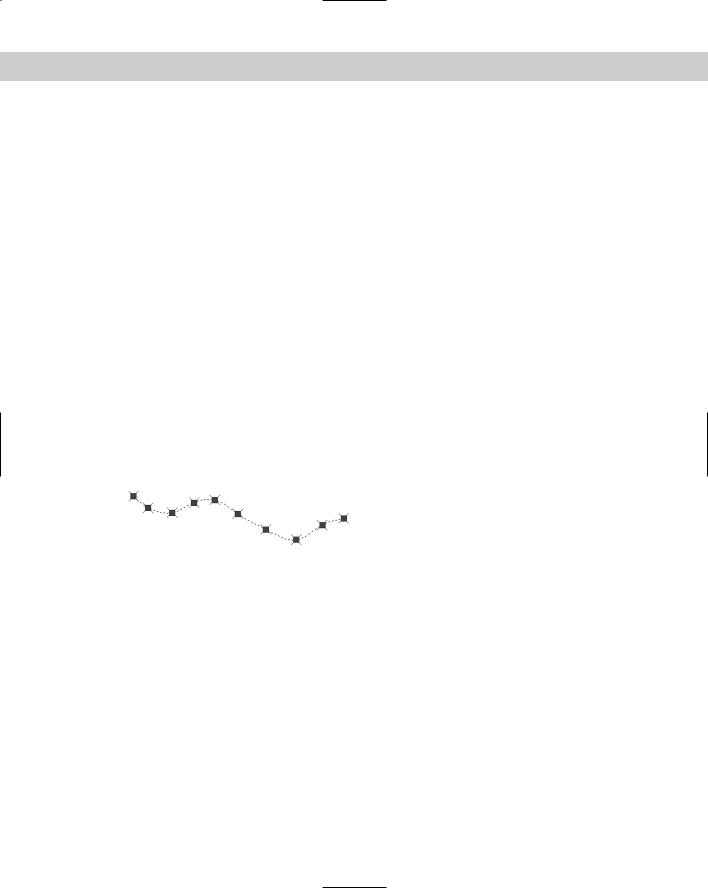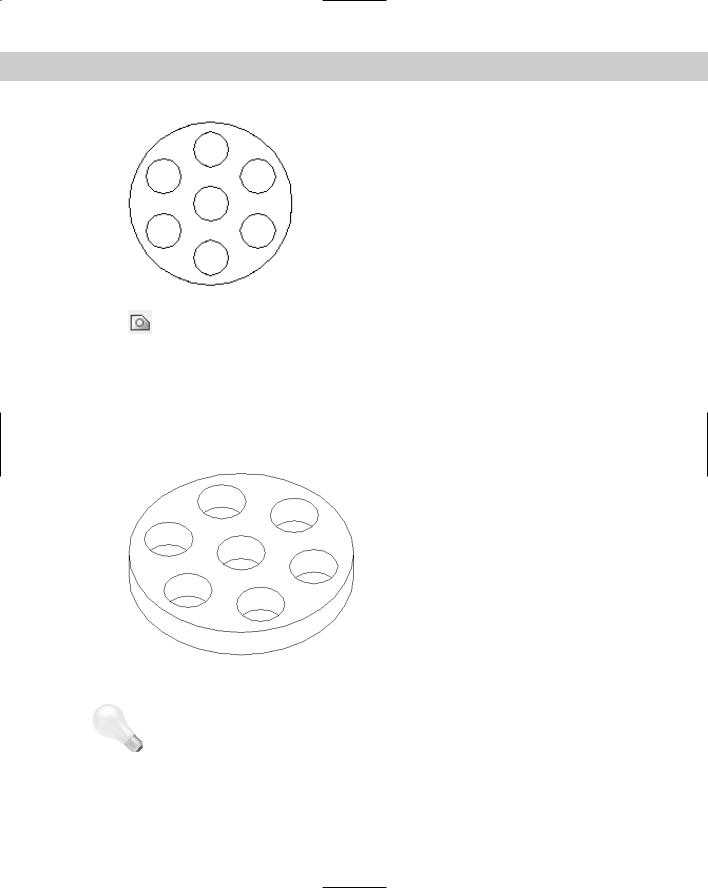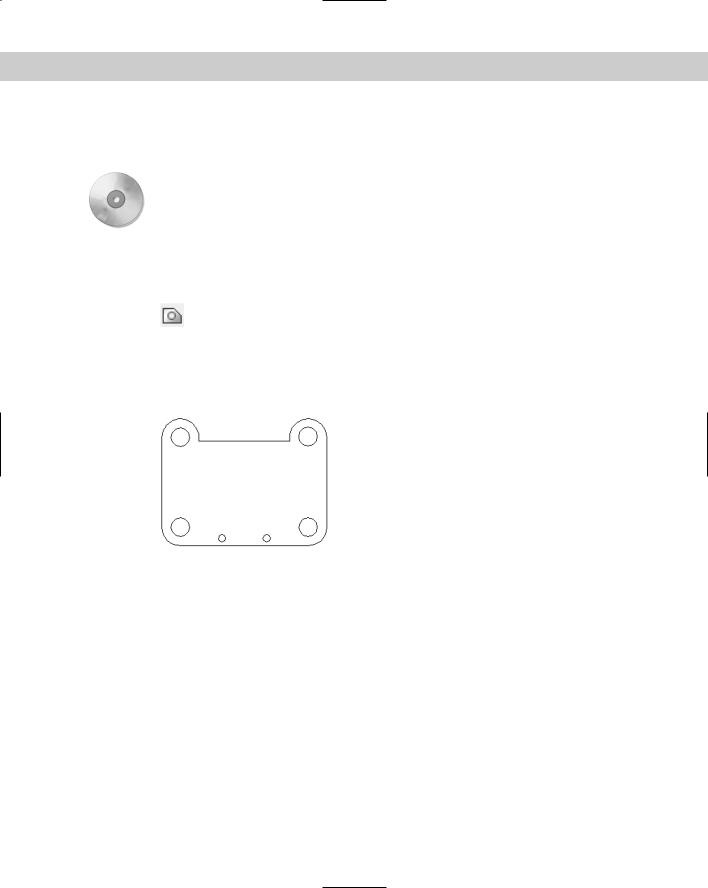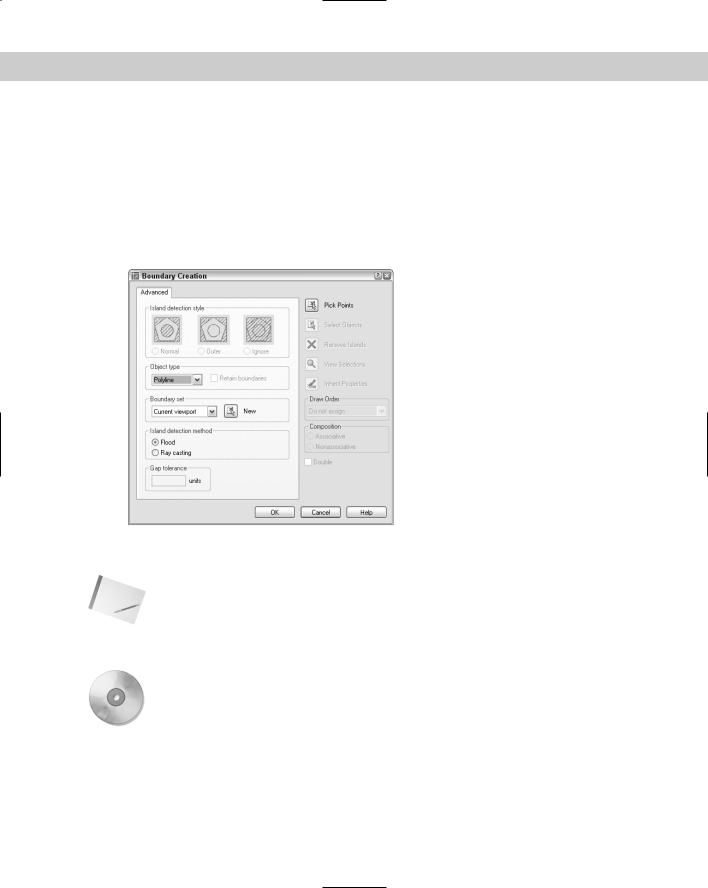
- •Foreword
- •Preface
- •Is This Book for You?
- •How This Book Is Organized
- •How to Use This Book
- •Doing the Exercises
- •Conventions Used in This Book
- •What the Icons Mean
- •About the CD-ROM
- •Other Information
- •Contacting the Author
- •Acknowledgments
- •Contents at a Glance
- •Contents
- •Getting Acquainted with AutoCAD and AutoCAD LT
- •Starting AutoCAD and AutoCAD LT
- •Creating a New Drawing
- •Using the AutoCAD and AutoCAD LT Interface
- •Creating Your First Drawing
- •Saving a Drawing
- •Summary
- •Creating a New Drawing from a Template
- •Working with Templates
- •Opening a Drawing with Default Settings
- •Opening an Existing Drawing
- •Using an Existing Drawing as a Prototype
- •Saving a Drawing Under a New Name
- •Summary
- •The Command Line
- •Command Techniques
- •Of Mice and Pucks
- •Getting Help
- •Summary
- •Typing Coordinates
- •Displaying Coordinates
- •Picking Coordinates on the Screen
- •Locating Points
- •Summary
- •Unit Types
- •Drawing Limits
- •Understanding Scales
- •Inserting a Title Block
- •Common Setup Options
- •The MVSETUP Command
- •Summary
- •Using the LINE Command
- •Drawing Rectangles
- •Drawing Polygons
- •Creating Construction Lines
- •Creating Rays
- •Summary
- •Drawing Circles
- •Drawing Arcs
- •Creating Ellipses and Elliptical Arcs
- •Making Donuts
- •Placing Points
- •Summary
- •Panning
- •The ZOOM Command
- •Aerial View
- •Named Views
- •Tiled Viewports
- •Snap Rotation
- •User Coordinate Systems
- •Isometric Drawing
- •Summary
- •Editing a Drawing
- •Selecting Objects
- •Summary
- •Copying and Moving Objects
- •Using Construction Commands
- •Creating a Revision Cloud
- •Hiding Objects with a Wipeout
- •Double-Clicking to Edit Objects
- •Grips
- •Editing with the Properties Palette
- •Selection Filters
- •Groups
- •Summary
- •Working with Layers
- •Changing Object Color, Linetype, and Lineweight
- •Working with Linetype Scales
- •Importing Layers and Linetypes from Other Drawings
- •Matching Properties
- •Summary
- •Drawing-Level Information
- •Object-Level Information
- •Measurement Commands
- •AutoCAD’s Calculator
- •Summary
- •Creating Single-Line Text
- •Understanding Text Styles
- •Creating Multiline Text
- •Creating Tables
- •Inserting Fields
- •Managing Text
- •Finding Text in Your Drawing
- •Checking Your Spelling
- •Summary
- •Working with Dimensions
- •Drawing Linear Dimensions
- •Drawing Aligned Dimensions
- •Creating Baseline and Continued Dimensions
- •Dimensioning Arcs and Circles
- •Dimensioning Angles
- •Creating Ordinate Dimensions
- •Drawing Leaders
- •Using Quick Dimension
- •Editing Dimensions
- •Summary
- •Understanding Dimension Styles
- •Defining a New Dimension Style
- •Changing Dimension Styles
- •Creating Geometric Tolerances
- •Summary
- •Creating and Editing Polylines
- •Drawing and Editing Splines
- •Creating Regions
- •Creating Boundaries
- •Creating Hatches
- •Creating and Editing Multilines
- •Creating Dlines
- •Using the SKETCH Command
- •Digitizing Drawings with the TABLET Command
- •Summary
- •Preparing a Drawing for Plotting or Printing
- •Creating a Layout in Paper Space
- •Working with Plot Styles
- •Plotting a Drawing
- •Summary
- •Combining Objects into Blocks
- •Inserting Blocks and Files into Drawings
- •Managing Blocks
- •Using Windows Features
- •Working with Attributes
- •Summary
- •Understanding External References
- •Editing an Xref within Your Drawing
- •Controlling Xref Display
- •Managing Xrefs
- •Summary
- •Preparing for Database Connectivity
- •Connecting to Your Database
- •Linking Data to Drawing Objects
- •Creating Labels
- •Querying with the Query Editor
- •Working with Query Files
- •Summary
- •Working with 3D Coordinates
- •Using Elevation and Thickness
- •Working with the User Coordinate System
- •Summary
- •Working with the Standard Viewpoints
- •Using DDVPOINT
- •Working with the Tripod and Compass
- •Getting a Quick Plan View
- •Shading Your Drawing
- •Using 3D Orbit
- •Using Tiled Viewports
- •Defining a Perspective View
- •Laying Out 3D Drawings
- •Summary
- •Drawing Surfaces with 3DFACE
- •Drawing Surfaces with PFACE
- •Creating Polygon Meshes with 3DMESH
- •Drawing Standard 3D Shapes
- •Drawing a Revolved Surface
- •Drawing an Extruded Surface
- •Drawing Ruled Surfaces
- •Drawing Edge Surfaces
- •Summary
- •Drawing Standard Shapes
- •Creating Extruded Solids
- •Drawing Revolved Solids
- •Creating Complex Solids
- •Sectioning and Slicing Solids
- •Using Editing Commands in 3D
- •Editing Solids
- •Listing Solid Properties
- •Summary
- •Understanding Rendering
- •Creating Lights
- •Creating Scenes
- •Working with Materials
- •Using Backgrounds
- •Doing the Final Render
- •Summary
- •Accessing Drawing Components with the DesignCenter
- •Accessing Drawing Content with Tool Palettes
- •Setting Standards for Drawings
- •Organizing Your Drawings
- •Working with Sheet Sets
- •Maintaining Security
- •Keeping Track of Referenced Files
- •Handling Errors and Crashes
- •Managing Drawings from Prior Releases
- •Summary
- •Importing and Exporting Other File Formats
- •Working with Raster Images
- •Pasting, Linking, and Embedding Objects
- •Summary
- •Sending Drawings
- •Opening Drawings from the Web
- •Creating Object Hyperlinks
- •Publishing Drawings
- •Summary
- •Working with Customizable Files
- •Creating Keyboard Shortcuts for Commands
- •Customizing Toolbars
- •Customizing Tool Palettes
- •Summary
- •Creating Macros with Script Files
- •Creating Slide Shows
- •Creating Slide Libraries
- •Summary
- •Creating Linetypes
- •Creating Hatch Patterns
- •Summary
- •Creating Shapes
- •Creating Fonts
- •Summary
- •Working with Menu Files
- •Customizing a Menu
- •Summary
- •Introducing Visual LISP
- •Getting Help in Visual LISP
- •Working with AutoLISP Expressions
- •Using AutoLISP on the Command Line
- •Creating AutoLISP Files
- •Summary
- •Creating Variables
- •Working with AutoCAD Commands
- •Working with Lists
- •Setting Conditions
- •Managing Drawing Objects
- •Getting Input from the User
- •Putting on the Finishing Touches
- •Summary
- •Understanding Local and Global Variables
- •Working with Visual LISP ActiveX Functions
- •Debugging Code
- •Summary
- •Starting to Work with VBA
- •Writing VBA Code
- •Getting User Input
- •Creating Dialog Boxes
- •Modifying Objects
- •Debugging and Trapping Errors
- •Moving to Advanced Programming
- •A Final Word
- •Installing AutoCAD and AutoCAD LT
- •Configuring AutoCAD
- •Starting AutoCAD Your Way
- •Configuring a Plotter
- •System Requirements
- •Using the CD with Microsoft Windows
- •What’s on the CD
- •Troubleshooting
- •Index

422 Part II Drawing in Two Dimensions
If you choose the Fit Data option, you see the Enter a fit data option [Add/Close/ Delete/Move/Purge/Tangents/toLerance/eXit] <eXit>: prompt. Descriptions of these options follow:
Add: Adds fit data points to the curve. The prompt asks you to select a point and then automatically selects the next point as well, shown with highlighted grips. At the prompt for a new point, which must be between the two highlighted points, the spline reshapes accordingly.
Open/Close: Opens or closes the spline using the fit points.
Delete: Deletes a selected fit point.
Move: Moves a fit point. You can use the Next or Previous suboptions or the Select Point option to select the point you want to move. Selected points appear as highlighted grips. You get a prompt for the new fit point location. You can also use grips to edit fit points.
Purge: Deletes fit point information.
Tangents: Enables you to specify start and end tangents of open splines, or one tangent for closed splines. If you don’t use this option, a default tangent is calculated.
toLerance: Enables you to specify the tolerance, which determines how closely the spline comes to the fit points.
eXit: Exits the suboption menu.
When you use SPLINEDIT and choose the Fit Data option, the grips appear on the fit points so that you can edit them, as shown in Figure 16-10.
Figure 16-10: When you use the Fit Data option of the SPLINEDIT command, the grips appear on the fit points.
You can edit a spline in the Properties palette. It works similarly to editing a polyline. You can choose the fits points or the control points and change them.
Creating Regions
Regions are two-dimensional surfaces. They look like closed polylines, but your drawing can calculate more information from regions than from polylines, such as the centroid, moments of inertia, and other properties relating to mass. You can also create complex shapes by combining, subtracting, and intersecting regions. Although these commands are most often used for 3D drawing, they’re often used in 2D drawing as a preparation for 3D drawing. You create a region from other objects. You can use closed polylines, closed splines, circles, ellipses, and combinations of lines, arcs, and elliptical arcs that create a closed shape. The shape cannot intersect itself like a figure-8.
Figure 16-11 shows a complex region. Although it looks like a circle with seven circles inside it, it’s actually a circular surface with seven holes in it. When you select it, you can see that it’s one object. The real proof of the pudding is when you try to extrude it to create a 3D object out of it. You can then view it at an angle, hide background lines, and clearly see the holes, as shown in Figure 16-12.

Chapter 16 Drawing Complex Objects 423
Figure 16-11: A complex region.
To create a region, choose Region from the Draw toolbar. The prompt asks you to select objects. Select all the objects and press Enter to end object selection. If all the objects
create a closed, nonintersecting shape, the prompt tells you:
1 loop extracted.
1 Region created.
The original objects are deleted. If your objects aren’t perfectly end-to-end, the prompt merely states:
0 loops extracted.
0 Regions created.
Figure 16-12: A region can be used to create a complex 3D object.
Tip |
If you want to keep the original objects when converting closed shapes to a region, change |
|
the DELOBJ system variable to 0 (off) before you use the REGION command. |
The BOUNDARY command (see the next section) offers a way to create regions in situations where objects are not neatly drawn end to end.
If you had a hatch inside the objects, you lose hatch associativity. You can rehatch the region if you want.

424 Part II Drawing in Two Dimensions
You can combine, subtract, and intersect regions to create complex objects. The three commands to accomplish these functions are UNION, SUBTRACT, and INTERSECT. These commands are discussed in Chapter 24 because they’re most often used in 3D drafting.
On the |
The drawing used in the following Step-by-Step exercise on creating regions, ab16-d.dwg, is |
CD-ROM |
in the Drawings folder on the CD-ROM. |
STEP-BY-STEP: Creating Regions
1.Open ab16-d.dwg from your CD-ROM.
2.Save the file as ab16-04.dwg in your AutoCAD Bible folder.
3.Choose Region from the Draw toolbar. At the Select Objects: prompt, use a selection window to select the entire model, shown in Figure 16-13. Press Enter
to end object selection. The prompt responds with this message:
7 loops extracted.
7 Regions created.
4. Save your drawing.
Figure 16-13: The outer profile and the six circles can all be turned into regions. The circles could then be subtracted from the outer profile to create a surface with six holes.
Creating Boundaries
The BOUNDARY command creates either polylines or regions from an enclosed area. This command has the capability of analyzing an area and ignoring intersecting lines that give the REGION command so much trouble. However, no spaces between objects are allowed. (Chapter 12 explains how to use the BOUNDARY command to calculate the area of a closed space.) Use the BOUNDARY command whenever you need to create a closed complex area. To create a boundary, choose Draw Boundary to open the Boundary Creation dialog box, shown in Figure 16-14. This dialog box is similar to the Boundary Hatch and Fill dialog box, covered later in this chapter. Most of the items in the dialog box are not active unless you’re creating a hatch.
Follow these steps:
1.The Object Type drop-down list determines the type of object BOUNDARY creates. Choose either Region or Polyline.
2.Choose the boundary set, which is the area to include in the analysis for the boundary. Usually, you can accept the default of Current Viewport. However, if you have a very complex drawing, choose New to temporarily return to your drawing. Specify a window around the area you want for the boundary set. You return to the dialog box.

Chapter 16 Drawing Complex Objects 425
3.To specify the enclosed area for the boundary, choose Pick Points. You return to your drawing with the Select internal point: prompt.
4.Pick any point inside the closed area you want for your boundary. Your drawing starts to think as follows:
Selecting everything...Selecting everything visible...Analyzing the selected data...Analyzing internal islands...
5.You then get a prompt for another internal point. If you want to create other boundaries, continue to pick internal points. Press Enter to end point selection.
Figure 16-14: The Boundary Creation dialog box.
The prompt informs you how many regions or polylines it created and ends the command.
Note By default, island detection is on. BOUNDARY detects enclosed areas that are totally inside the boundary area and creates polylines or regions of those enclosed areas as well.
When BOUNDARY creates a region or polyline, the original objects are not deleted. You end up with a region or polyline on top of your original objects.
On the |
The drawing used in the following Step-by-Step exercise on creating boundaries, ab16-e. |
CD-ROM |
dwg, is in the Drawings folder on the CD-ROM. |
STEP-BY-STEP: Creating Boundaries
1.Open ab16-e.dwg from your CD-ROM.
2.Save the file as ab16-05.dwg in your AutoCAD Bible folder. This is a bushing, shown in Figure 16-15.
